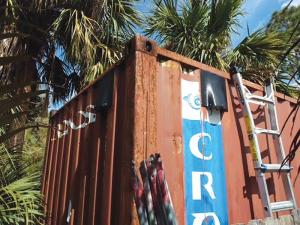2021 - Volume #45, Issue #4, Page #26
[ Sample Stories From This Issue | List of All Stories In This Issue | Print this story
| Read this issue]
Passive Vent Keeps Containers Dry
 |
 |
“The 360 Tunnel system includes an intake port and an exhaust port with a specially curved cover,” says Greg Cravens, 360 Products North America. “As ambient air moves across the cover, it creates a low-pressure area behind the cover that draws air through the intake port.”
Cravens likens it to the curve of an airplane wing that provides lift. Based on the Venturi effect, it pulls air through a shipping container, even in low wind situations.
“Anything over a mile an hour works, but 4 to 5 miles per hour is ideal,” says Cravens. “Even spraying a hose past the exhaust pulls air out.”
He credits Ron Perry, an engineer and inventor from Canada, for coming up with the concept. An RV owner, Perry was seeking a chemical-free solution for holding tank odor. After several tries, he came up with the 360 passive system. The design for holding tanks for RVs, boats and even home septic systems uses a siphon effect to draw odors from near the surface up and through the exhaust vent.
Perry contacted Cravens’ brother Bob, who had worked in the RV industry for 35 years. He recognized the potential of the venting system and, with Greg, took on distribution.
Contact with an owner of a shipping container used for storage took the company in a new direction. “Shipping containers are water and airtight for ocean transport,” says Craven. “When the outside temperature drops at night, condensation occurs inside. It’s called container rain.”
Perry came up with the 360 Tunnel design to respond to the interest. One of the early customers for it was trying to store grain in large totes in a shipping container in Texas. He set the 1-ton totes on a layer of pallets that ran the length of the container and still lost as much as 30 percent of the grain to mold - until he tried the new design.
“After installing our vents, he told us the last handful was as dry as the first,” says Cravens, who sent him a moisture sensor to track effectiveness. “Our vent system kept humidity constant at 14 percent throughout the year.”
The simplicity of how the system operates is matched by how easy it is to install. Installation requires no screws, rivets or welding. Cut holes with an angle grinder at opposite ends of the container for the intake and the exhaust. Adapter plates are needed when installing on side or rear walls, but not on the doors.
“We recommend 1 exhaust ($108) and 1 intake ($59) on a 20-ft. container and 2 exhausts and 1 intake on a 40-ft. container,” says Cravens. “Install the exhausts at floor level for fumes and gas extraction or ceiling height for moisture and heat control.”
He recommends the 360 venting system for residential use as well. “I replaced a powered fan with louvers in my garage,” he says. “The airflow is powerful enough to pull air even through a furnace filter.”
Contact: FARM SHOW Followup, 360 Products North America, P.O. Box 21539, Keizer, Ore. 97307 (ph 812 798-0787; gregory.cravens@sbcglobal.net; www.360productsnorthamerica.com).

Click here to download page story appeared in.

Click here to read entire issue
To read the rest of this story, download this issue below or click here to register with your account number.




